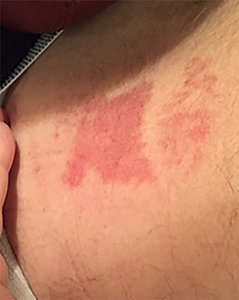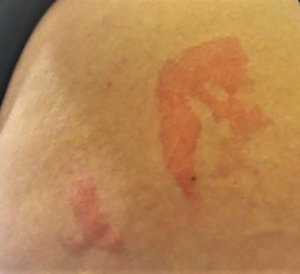I generally don't discuss dermatological problems, but this case has a rather interesting history and a lesson about which we should all be aware.
A 61-year-old patient presents with pain and a rash on his lower back and torso. (Figure 1) Rash has been present for a couple days and is not improving. A clinician at an urgent care clinic told him it might be shingles or an allergic reaction and recommended that if it did not improve, he should see a dermatologist.
Now he has seen two different clinicians and neither one knows what it is. The patient's wife is the one who finally figures out the mystery.
What's the Cause?
As usual, the key is the history, which is that the patient has chronic low back pain and often uses an ice pack to alleviate his symptoms. Neither clinician asked the simple question: "Did you put anything on your back within the past 24 to 48 hours?" This is a burn from an ice pack, as the patient's wife finally figured out.
 Figure 1
Improper / prolonged application of ice or cold packs can cause damage to the skin, leading ultimately to a thermal burn. Placing a layer of material, e.g., a towel, between the skin and ice or ice pack will help prevent ice burn.
Figure 1
Improper / prolonged application of ice or cold packs can cause damage to the skin, leading ultimately to a thermal burn. Placing a layer of material, e.g., a towel, between the skin and ice or ice pack will help prevent ice burn.
The ice pack should not be left on for longer than 10-20 minutes. I would err on the side of caution and tell the patient 15 minutes max; if the injury is in an area with little fat or muscle beneath the skin, such as fingers, take the compress off after 5 to 10 minutes maximum, wait 10 minutes and then reapply.
Another Case to Consider
Here's one more example just to emphasis my point. (Figure 2) This patient is a 56-year-old seasoned runner who developed hip pain after a run. She often used ice packs for relief of minor muscle strain or sprain with good results. This time she was in a hurry and just threw an ice pack on her hip and forgot about it. She did not use any towel to protect the skin. The pack was new and apparently had a cloth-like layer around it, which may or may not have been protective. Two hours is too long for any thermal therapy!
 Figure 2
Treating an Ice Burn: Quick Tips
Figure 2
Treating an Ice Burn: Quick Tips
Treatment for an ice burn, first and foremost, is to remove the ice from the skin. Then, the process of warming the area needs to be gradual to avoid causing further damage.
Note: This is the opposite for heat burns which require cooling as quickly as possible.
Using a towel soaked in warm water or soaking the ice burn region in a warm bath can gradually increase the temperature without doing further damage. Do not use hot water.
Blisters are also a possibility when the skin has been burned with ice. Treatment for blisters is the same for ice as heat. Do not pop the blisters. Applying an antibiotic ointment helps reduce the risk of infection. Keep the area clean, moist and wrap with loose gauze.
If the skin remains cold, hard or numb after the above-mentioned treatments, advise the patient to seek medical attention quickly. This is a sign of severe thermal damage.
Final Thoughts
I don't think we impress upon our patients the proper use of ice packs. The treatment recommendation for a simple sprain or strain remains the same: Rest, Ice, Compression and Elevation (RICE). Patients must be warned never to place ice or an ice pack directly on the skin, no matter what the packaging / package states.
Advising your patients on how to treat a minor ice burn will probably protect them from injury – or a look at some of the images on the Internet might get their attention.
Resources
- O'Toole G, Rayatt S. Frostbite at the gym: a case report of an ice pack burn. Br J Sports Med, 1999 Aug;33(4):278-9.
- "Everything You Need to Know About Ice Burn." Healthline.com: https://www.healthline.com/health/ice-burn.
- Cadman B. "Everything You Need to Know About Ice Burns." Medical News Today: https://www.medicalnewstoday.com/articles/322606.php.
Click here for more information about Deborah Pate, DC, DACBR.





